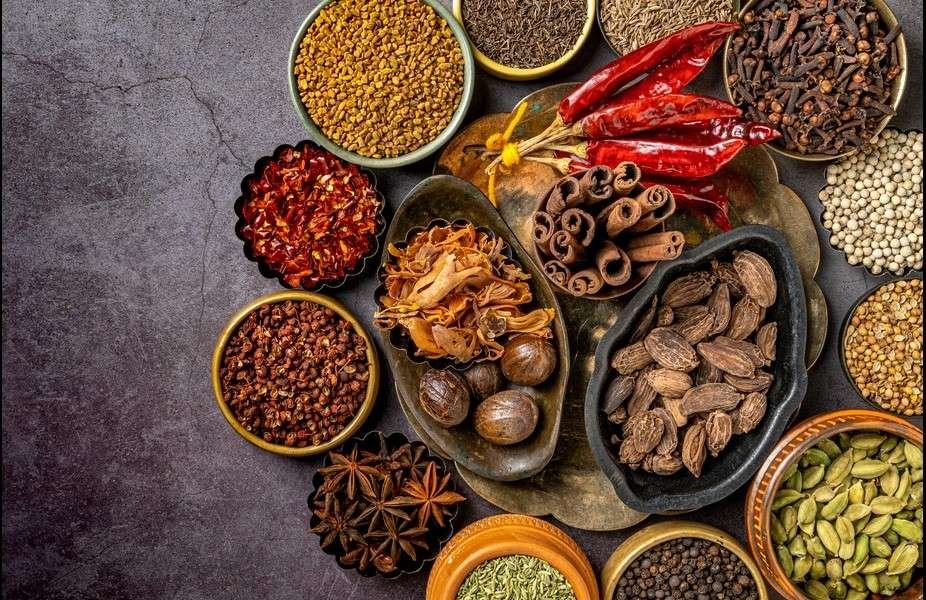Indian cuisine is attributed to its richness in flavour, aromatic spices, and vibrantly appealing colours. The unexplained magic in Indian dishes empowers every difference in the use of spices. Ever wondered just why your favourite curry or biryani tastes so divine? The answer lies in the spices.
In this blog, we will review the top 10 Indian spices used in most Indian restaurant and how they contribute to the unique flavours of Indian food.
Top 10 Spices in Indian Cuisine
1. Cumin (Jeera)
Cumin is one of the most fundamental spices in Indian cooking and is hailed for this earthy, slightly peppery flavour. Often used in its whole form, it is fried in oil to release its aromas, while it can also be ground into cumin powder to be added to dishes. Cumin is used in many spice mixes, specifically garam masala and curry powder. Cumin is used in everything, be it vegetables, meats or even chutneys.
2. Coriander (Dhania)
Another fundamental spice found in Indian cuisine is coriander. It has a subtle aroma of citrus and is enjoyed both in its leaf and seed forms. Coriander seeds are typically roasted, then ground into powder as an additive to various curries, soups, and marinades. Fresh leaves are used as garnishes, which release intense freshness upon chewing; in the West, this herb is called cilantro.
3. Turmeric Powder (Haldi)
Turmeric is likely the most widely known Indian spice, with its bright yellow colour and an earthy, slightly acidic-bitter taste. It features nearly in every Indian dish as a flavouring to curries as well as rice and lentils. Turmeric enhances not only flavour but also colour, and its medicinal properties are well appreciated for pro viding an ingredient with anti-inflammatory property. One of its major applications is in spice mixes such as curry powder and in diverse medicinal Indian traditional beverages, such as haldi doodh.
4. Garam Masala
Garam Masala is an adventurous spice mix comprising an array such as cumin, coriander, cardamom, cloves, cinnamon, to name it all. The blend of these spices creates a warm and aromatic flavour often used to finish off many Indian dishes. This blend is added as part of its ingredients or garnishes toward the end of cooking a dish to pull out enhanced flavours.
5. Cardamom (Elaichi)
Cardamom is a fragrant spice; in which one will find sweet, floral undertones in the flavour. The aromatic green cardamom pods are infused with and added to rice dishes, curries, and sweet dishes such as kheer—a lovely way to infuse this spice further is to grind the seeds into a powder and place them in a little sachet, then infuse them in spice blends or tea, chai.
6. Cloves (Laung)
They have intensely aromatic scents with a mawkish, sweetly sharp taste. Generally, it is used to flavour rice, meat, and several Indian spice mixtures. They are also the main ingredients in garam masala and biryani masala. Besides the flavour, cloves also present some medicinal value, that includes promoting digestion and relieving toothache.
7. Mustard Seeds (Rai/Sarson)
The mustard seeds are one of the most widely used ingredients in Indian cooking. Particularly, in South Indian cooking, in which they are very prevalent. These are tiny seeds that, when popped, release a nutty flavour, especially when fried in hot oil, ideally for tempering spices used in making curries, dals, and chutneys. The extracted oil is also used in their cooking and is one of the mostly consumed cooking mediums across the households in India.
8. Fenugreek (Methi)
The seeds have a slightly bitter taste and are quite often used in spice mixes, pickles, and curries. The leaves, known as methi, have an extremely characteristic taste and are cooked in a similar manner. Fenugreek is used widely in different dishes, including those from the Indian subcontinent, such as methi chicken and methi paratha. It is said to be healthy with the property of good digestion and anti-inflammatory.
9. Cinnamon (Dalchini)
Because cinnamon is a sweet and warming spice, it lends very well to heavy meat dishes and meats in general, biryanis, and sweet foods. In rice dishes and curries, one of the common practices is to add the whole, thick cinnamon sticks to give dishes the rich scent and flavour. Ground cinnamon is also used in spice mixes like garam masala.
10. Chili Powder (Mirchi Powder)
A bit of heat is required to accentuate the taste of most Indian dishes, perhaps; the most used spice to provide that would be chili powder. Made from dried red chilies, Indian chili powder can range from a medium heat to a severe pungency. It is an extensively used spice in almost all Indian dishes, including curries, stews, marinades, and snacks.
Conclusion
Indian cuisine, one of the most delightful amalgamations of flavours, is made distinctive due to these spices. So, whether you’re a passionate home cook looking to replicate your favourite Indian dishes, or maybe just curious about the secret behind the magic of your favourite Indian restaurant in Niagara Falls, understanding these top 10 Indian spices brings you a little bit closer. Apart from the fact that each has an individual flavour, spice plays an important part in the complexity of Indian cuisines. So the next time you go to relish a tasty curry or biryani, you’ll know exactly what’s contributing toward that awesome taste!
